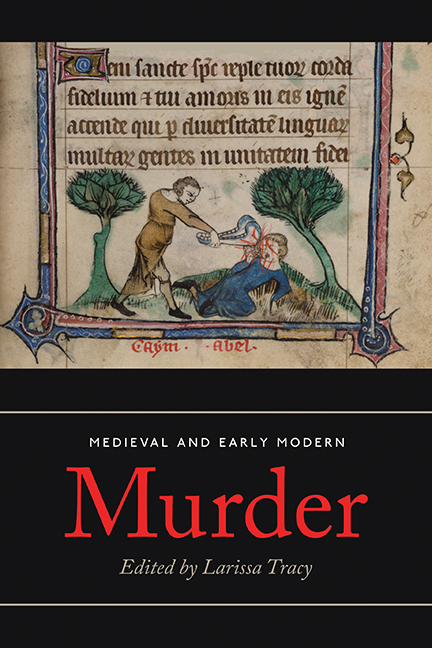Book contents
- Frontmatter
- Contents
- List of Illustrations and Tables
- Acknowledgements
- Contributors
- List of Abbreviations
- Introduction: Murder Most Foul
- I Murder on Trial: Justice, Law and Society
- II The Public Hermeneutics of Murder: Interpretation and Context
- III Murder in the Community: Gender, Youth And Family
- Conclusion
- Select Bibliography
- Index
Conclusion
Published online by Cambridge University Press: 05 July 2018
- Frontmatter
- Contents
- List of Illustrations and Tables
- Acknowledgements
- Contributors
- List of Abbreviations
- Introduction: Murder Most Foul
- I Murder on Trial: Justice, Law and Society
- II The Public Hermeneutics of Murder: Interpretation and Context
- III Murder in the Community: Gender, Youth And Family
- Conclusion
- Select Bibliography
- Index
Summary
TAKEN TOGETHER, THESE ARTICLES serve as a powerful corrective to lazy stereotypes of the Middle Ages as horrifically and unthinkingly brutal. It is perhaps ironic that a volume devoted to the subject of murder should have this effect, and certainly we do not emerge with any rose-tinted illusions about the level of violence in medieval life. But we do gain a sense of the complexity and sophistication of responses to fatal violence. Whether or not medieval reasoning resonates with our own, contemporaries wrote, spoke about and listened to accounts of violence with an almost obsessive interest which went beyond the prurient. As these essays reveal, it was a subject whose dubious moral framework provoked anxiety and ambivalence.
Of course, if murder was a common medieval literary theme, this was partly because of its theatrical potential: it has drama, often mystery and a good deal of human interest. A medieval crowd-pleasing example which usefully embodies many of the observations which follow about this volume is the play La Femme du Roy de Portugal (1876): it contains multiple murders. This is a reworked narrative from the Vie des Pères, a popular collection of miracle stories from the mid thirteenth century, surviving in over thirty manuscripts. The play version was produced for the annual festivities of the Parisian guild of goldsmiths. Over the course of the play, the soon-to-be-Queen is raped by the King's Seneschal, whom she subsequently murders. Realising that this jeopardises her role as a virgin on her wedding night, she persuades another woman to replace her for the one night, only to find the other woman unsurprisingly reluctant to relinquish her place. The Queen, in despair, murders the woman who is attempting to usurp her place. Condemned by law to death, she is rescued at the last minute by the efforts of the Blessed Virgin Mary. The story makes splendid theatre, keeping the audience breathless with the melodrama and tension of it all. It is also a highly problematic tale, not least because of the extreme levels of violence, and it is surely this problematic nature which was designed to keep the audience rapt by a series of moral and legal knots which cannot easily be disentangled.
- Type
- Chapter
- Information
- Medieval and Early Modern MurderLegal, Literary and Historical Contexts, pp. 456 - 467Publisher: Boydell & BrewerPrint publication year: 2018

